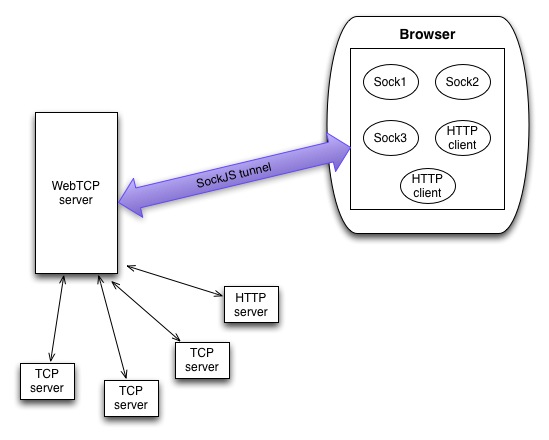WebTCP 0.0.1
WebTCP is a SockJS/TCP bridge that allows browsers to interact with remote TCP servers and make HTTP requests to any servers bypassing same-origin policy.
How does it work
Client and server (bridge) communicate through SockJS connection. When browser
wants to create a TCP socket it sends a command to the bridge. Bridge creates a real TCP socket connection and maps all the events
that happen on this socket to a client's socket object. For example, when data is received bridge will trigger a data event on
according socket object on a browser side. Screw my writings, here's the picture:

Why would anyone need that
I don't know, but you can do interesting things like:
- create client libraries to interract with any TCP servers 'directly' from your browser: Redis, Memcached, MySQL, MongoDB, etc.
- make GET/POST queries to any destination regardless of same-origin policy.
Installing
Assuming you have node.js and npm installed:
Clone the repo
git clone https://github.com/yankov/webtcp
Install dependencies
cd webtcp
npm install
Run WebTCP server
cd examples && node server
Running examples
TCP echo server
cd examples && node echo_server run example echo server
Open client examples in the browser
examples/http_client.html for http requests examples
examples/socket_client.html for socket examples
How to use it
=============
First create a SockJS tunnel. Use whatever port and address your WebTCP server is on.
var net = new WebTCP('localhost', 9999)Creating sockets
Now you can create sockets like this
var socket = net.createSocket("127.0.0.1", 1337)To send data simply use write function
socket.write("hi") Standard event handlers
// On connection callback
socket.on('connect', function(){
console.log('connected');
})
// This gets called every time new data for this socket is received
socket.on('data', function(data) {
console.log("received: " + data);
});
socket.on('end', function(data) {
console.log("socket is closed ");
});It's also possible to specify advanced options when creating a socket connection
options = {
encoding: "utf-8",
timeout: 0,
noDelay: true, // disable/enable Nagle algorithm
keepAlive: false, //default is false
initialDelay: 0 // for keepAlive. default is 0
}And then pass those options when creating socket
var socket = net.createSocket("127.0.0.1", 1337, options)Making HTTP requests
Making HTTP request is pretty straightforward.
Create a http client
var client = net.createHTTPClient() GET request
client.get({ host: 'news.ycombinator.com', port: 80 }, function(res) {
console.log(res);
});POST request
client.post({ host: 'news.ycombinator.com', port: 80 }, { param: 1 }, function(res) {
console.log(res);
});Implemented clients
There're clients for Redis and Memcache included. Work on a client for Apache Kafka is in progress. Check out examples for redis and memcache clients. Should be pretty straight forward.
TODO
- Security checks [hello vkluch?]
- Fix client for Apache Kafka
- Rails rack middleware (probably for HTTP only)